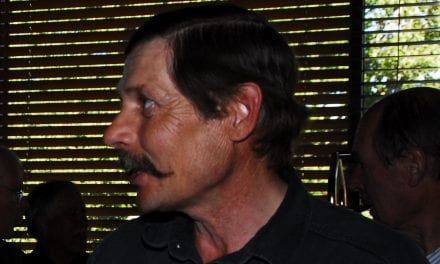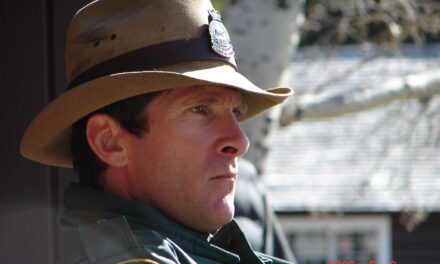Where and what year were you born?
Calgary Alberta. 1954.
Where and how did you spend your growing-up years?
In the Calgary area and the mountains. My parents took me and my sisters on hikes and trail rides. We learned to ride horses at ranches north and west of Calgary and took some great trail rides and hikes in the Siffleur and Whitegoat Wilderness areas before they were well known. We hiked many times into the Mt. Assiniboine area and I first met Ken Jones and Lizzie Rummel there. Ken was the park warden and Lizzie owned and ran the tent camp near Sunburst Lake.
Why did you want to join the Warden Service?
I enjoyed horseback riding and being out of doors and was pursuing a degree in the natural sciences. In those days, law enforcement, public safety and resource conservation were all duties of a warden, and I thought I could contribute on the resource conservation side anyway.
Which national park did you start working in?
Kootenay National Park in 1974, and I stayed there as a seasonal warden until 1977.
What were your main responsibilities as a Warden over the years?
Kootenay was a small park, so the seasonal wardens had all the same responsibilities as the permanent wardens – law enforcement, resource conservation studies and public safety, mainly.
What did you like most about being a warden? What did you least like?
I liked the opportunity to study ecosystems in the alpine, subalpine and montane, although I wasn’t quite that conversant with the terms at the time. I got unique opportunities to work on wildlife studies. Although I keep to myself mostly, I did enjoy the socialization with other wardens and park employees. Although I didn’t like law enforcement that much, I did enjoy a couple of aspects, namely the ability I had to act on what I always had wanted to do when I saw people feeding bears or spray painting rocks. I least liked campground patrols (drunks, domestic incidents), highway patrols during busy holiday weekends (accidents, drunks, random campers) and writing out parking tickets in the Aquacourt parking lot. And I didn’t care that much for Parks bureaucracy either.
What are some of the more memorable events of your Warden Service career?
I only worked seasonally for four years but I had a lot of experiences in that time. I remember the mountain climbing training sessions with Peter Fuhrmann whose terse expression of my abilities “Downing is a nervous climber” pretty much reflected my enthusiasm about vertical slopes like the Grilmaier Traverse in Banff. Hans Fuhrer was the public safety specialist in Kootenay during 1976 and 1977 and was a patient mentor. We (Fuhrer, Brown, Downing) apparently made the first (recorded) ascent of Mt. Harkin in I think 1977.
In 1976-77, Parks Canada took a more “formal” approach to resource management and under Kurt Seel’s direction, management plans were developed for the mountain parks, including Kootenay. Because I was a good writer and pretty much the only person in the Kootenay warden service who had any interest in plants, I was given the vegetation management component to write up. I have no idea whether it was ever used but Kurt had a lot of comments. Parks needed to spend some money in the late fall of 1977 so they kept me on for a few weeks to do a forestry/vegetation survey of Redstreak Campground. I started it in early October when everything was dead and most plants were hard to identify, and finished it near the end of October when I had to clear snow off the plots and broke an increment corer that froze inside an old Douglas fir. I bet that report gathered dust and it wasn’t used in the 1984 Park Ecological Land Classification report; no surprise there. But I kept busy and had a place to live for a few more weeks after the seasonal job was over.
My most memorable experience involved the elk study that Terry Gibbons was in charge of. He was a very relaxed guy and a great boss, and I was lucky that he chose me to help. The purpose of the study was to determine where elk went once they left Kootenay Park. We used the relatively new technology of radio-collaring to track them. It involved immobilizing mainly cow elk, fastening the radio collar, and taking a blood sample for the vets. Most of the work I was involved with was late summer to late fall and we did both ground and aerial surveys. No such thing as GPS back then so maps and rough triangulation were our low-tech approach. We used an immobilizing agent called Anectine that didn’t require a special permit unlike narcotic tranquilizers. We administered it with a tranquilizing gun and it was, so to speak, hit and miss whether it took effect. We regretted that the animals were fully aware of what we were doing and we attempted to minimize stress by covering their heads with a jacket. The immobilizing agent was sent as powder in a plastic bottle. It had to be diluted with distilled water and Terry warned me not to trust the fill mark on the bottle but to measure accurately with a syringe. One time I ignored that advice and found out that spike bulls are surprisingly strong when insufficiently immobilized and could easily gore the unprepared. I was lucky and Terry was amused.
Can you tell me about any rescue/wildlife/fire/enforcement/other stories that stick out in your memory?
I only participated in two public safety activities. One was the rescue of a St. Bernard that had slipped above the falls at Marble Canyon and managed to haul out on a rock ledge deep in the canyon. Brian Sheehan rappelled down and rescued the dog and I helped with the cable rescue. The other was a young woman who slipped above Numa Falls; fortunately for her, it was low water and she too pulled herself out on a ledge just below the bridge. Gord Watkins, another seasonal warden at the time, brought her up to safety.
How did the Warden Service change over the years? – centralization, affirmative action, focus on public safety, changes in 1990s & 2000’s
I left on a high note, I guess, as from what I’ve read the Warden Service has since gone through some major changes that not everyone liked.
What aspects of the warden’s job were most important to you?
Contributing to a better understanding of plant ecology and wildlife. Working with interesting people.
Are there any legends or stories associated with the Warden Service that you can share or stands out in your mind?
For me, Sid Marty covers all that in his book (Men for the Mountains) and I can relate to many of the stories he presents.
What do you want future generations to know about the Warden Service as you knew it?
It was a good place to work when I was there and I am fortunate to have had the experience.
What made the past and current Warden Service such a unique organization?
I don’t know what makes the current Warden Service unique as it seems like a police force, but the period during and before I worked there required people who were resilient and adaptable enough to change focus from day to day sometimes in a major way, as many of the long-time wardens have reported in their interviews.
Do you have any lasting memories as a Warden? Favorite Park, cabin, horse, trail, humorous stories, etc.
I’ve pretty much covered them above. Certain wildlife species bring memories back – like the elk (elk study) and bighorn sheep. One time I had the experience of watching two rams butt heads five feet from me at eye level; I was sitting in my truck on the road up to the bunkhouse, and these two were oblivious to my presence as they battled on the low cutbank above the road. I could see bits of horn fly off and my ears rang from the noise of their collision.
One humorous story involved Terry and the chief park naturalist, Ian Jack, who was also a great guy. Park management approaches to fire management in the mid to late ‘70’s were changing and “let it burn” policies were considered. We were at a staging area on the flats near Vermilion Crossing and there was a fire way up the valley where there wasn’t much chance of it spreading anywhere but a few people were up there with shovels and backpack water pumps. Terry was stretched out on a few hose bags, enjoying the morning sun and smoking a cigarette. Ian strode over to him and as I recall the conversation went something like this:
Ian: “Hey Terry, what’s going on? I thought we were going to let fires burn if they weren’t a threat to people or structures. So why are you up there fighting it?”
Terry (chuckling): “I’m not”.
Do you ever miss being a Warden or a Resource Conservation specialist?
No, because I went on to pursue work with an inventory focus and learned a lot more about the integration of vegetation, soil, climate, geology and topography than I would have if I had stayed. I did apply a couple of times to be permanent, but that door seemed to be closed and my boss Terry said that I could do better for myself. So, I returned to graduate school and was then hired by the Alberta government to do ecological surveys with a lot of very talented people.
What year did you retire or leave Parks Canada? Presuming you are now retired, what do you enjoy doing during your retirement?
1977 was my last year with Parks. I mostly retired around 2012 from my work as an ecologist and enjoy doing what I want mostly on my own schedule.
Is there anyone else from the Warden Service you would suggest we talk to?
Gord Watkins if you can get hold of him. I really wish Terry was still alive to relate his story as he had some great ones to tell, but sadly he died of cancer in 1980.



